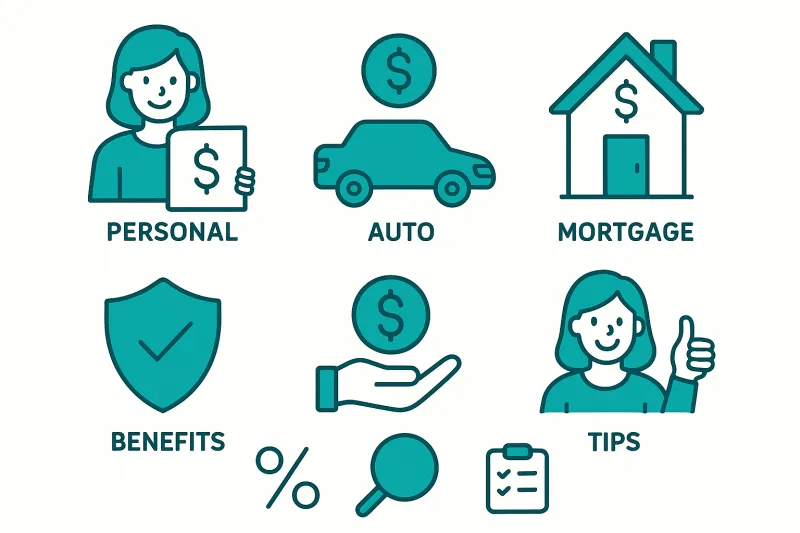Understanding Loans for Money: Your Guide to Personal Finance
- Personal Finance
- 04 Mins read

Understanding Loans for Money
Navigating personal finance can feel overwhelming, especially when it comes to loans. Whether you are a first-time borrower or someone looking to refinance existing debt, understanding how loans work is crucial. Let's explore the types of loans available, their benefits, and essential tips for securing the best rates.
What Are Loans?
A loan is a sum of money that you borrow from a lender with the agreement to pay it back later, usually with interest. There are several types of loans, including personal loans, home loans, and auto loans. Each serves different purposes, so it's essential to understand which one fits your needs.
Types of Loans
1. Personal Loans
These are unsecured loans that you can use for various purposes, such as consolidating debt, making a large purchase, or covering unexpected expenses. Since they do not require collateral, interest rates can be higher compared to secured loans.
2. Home Loans
Home loans, or mortgages, help you purchase property. They typically come with lower interest rates because your home serves as collateral. In my ten years as a mortgage broker, I have seen many first-home buyers struggle with this process, but taking time to understand the terms can save you thousands in repayments.
3. Auto Loans
These loans are specifically for purchasing vehicles. Like home loans, auto loans are secured with the vehicle you’re buying, which often results in lower interest rates. It's essential to shop around for the best rates and terms.
The Benefits of Loans
Loans can be incredibly beneficial if used wisely. Here’s how they can help you:
- Access to Funds: Loans provide immediate access to funds, allowing you to make significant purchases or investments.
- Flexibility: Most loans allow flexible repayment terms tailored to your budget.
- Build Credit: Responsible borrowing and timely repayment can improve your credit score, which can help you secure better rates on future loans.
Understanding Interest Rates
Interest is the cost of borrowing money. It is expressed as a percentage of the loan amount. Understanding how interest works is crucial for managing your loan effectively.
Fixed vs. Variable Rates
- Fixed Rates: These rates remain constant throughout the life of the loan, providing predictable monthly payments.
- Variable Rates: These can fluctuate based on market conditions, which means your payments could increase or decrease over time.
Example: If you borrow $10,000 at a fixed rate of 5% for five years, you will pay a consistent amount every month. In contrast, if you choose a variable rate, that 5% could rise, affecting your monthly budget.
Compound Interest Made Easy
Compound interest is interest calculated on the initial principal and also on the accumulated interest from previous periods.
Illustrative Case Study: Let's say you take out a $5,000 personal loan at a 10% annual interest rate compounded monthly. After one year, you'd owe approximately $5,500. However, by the end of year five, without any repayments, you'd owe close to $8,800.
This demonstrates why understanding the implications of compound interest is vital when considering a loan. Compound interest can amplify both savings and debts, making it essential to manage loans wisely.
Tips for Securing the Best Loan Rates
1. Shop Around
Don’t settle for the first offer you receive. Different lenders have varying rates and terms. Use comparison websites to find the best fit for your needs.
2. Improve Your Credit Score
A higher credit score often translates to better interest rates. Check your credit report for errors and pay down existing debts to boost your score.
3. Confirm Your Budget
Understand what you can afford before applying for a loan. Take into account monthly payments, fees, and how they fit into your overall financial picture.
4. Consider the Total Cost
Look beyond just the interest rate. Consider any fees, like establishment fees or application fees, that could increase the overall cost of your loan.
Common Loan Myths
Myth 1: All Lenders Are the Same
This is far from true. Different lenders have various lending criteria, interest rates, and fees. Research is vital.
Myth 2: You Need Perfect Credit to Get a Loan
While a higher credit score can help, some lenders offer loans to individuals with less-than-perfect credit. You may pay a higher rate, but options are available.
The Loan Application Process
Navigating the loan application can seem daunting, but understanding the process can ease your worries.
- Pre-Approval: Start by applying for pre-approval, which gives you an idea of how much you can borrow and at what rate.
- Gather Documents: Common documents required may include proof of income, identification, and a list of assets and liabilities.
- Submit Application: Once you’ve chosen your lender, submit the application with your documents.
- Loan Decision: The lender will assess your application and either approve or decline it.
- Receiving Funds: If approved, you will be given the terms of your loan before receiving the funds.
Managing Your Loan
Once you have your loan, it’s crucial to manage it properly:
- Keep Track of Payments: Use reminders or automatic payments to avoid missing due dates.
- Create a Budget: Factor in your loan repayments to ensure you can manage them alongside your other expenses.
- Communicate with Your Lender: If you encounter financial difficulties, don’t hesitate to reach out to your lender. They may offer options like hardship programs.
Conclusion
Understanding loans is a pivotal aspect of managing personal finance. By knowing the types of loans available, how interest works, and the application process, you can approach borrowing with confidence. The most important takeaway is to do your research and assess your financial situation carefully.
As you move forward, remember: "The best time to plant a tree was 20 years ago. The second best time is now." Don't wait until a financial emergency arises. Take control of your financial future today by understanding your options and making informed decisions.
Whether you're buying a home, purchasing a car, or simply consolidating debt, having a firm grasp of loans can set you on the path to smart financial decisions.



